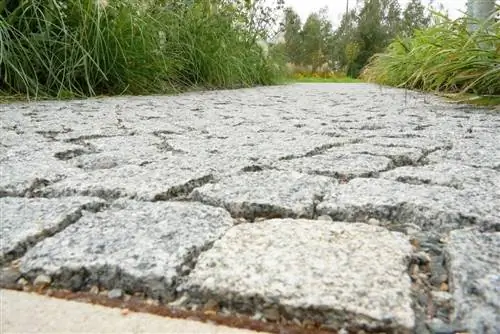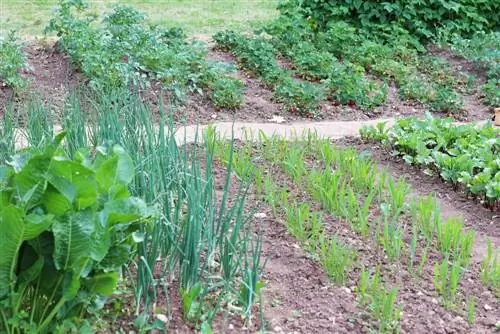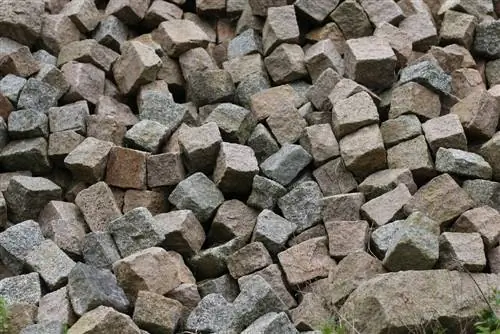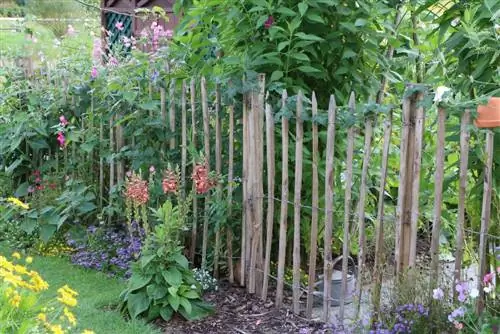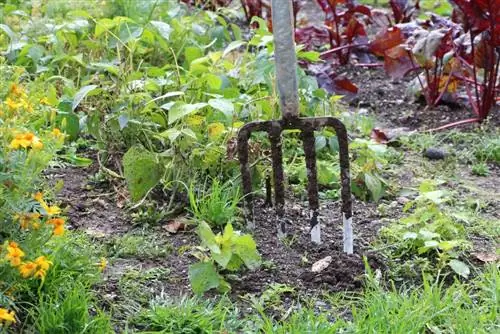- Author admin [email protected].
- Public 2023-12-17 03:39.
- Last modified 2025-06-01 06:48.
If you limit paving to the purely functional task of paving a surface, the gate to an imaginative world of creative garden design remains closed. Paving made of natural stone, clinker or concrete, with its stone longevity, forms the ideal counterpoint to the growth and decay of garden plants. A variety of shapes and beautiful colors enable individual design variations for every style and every budget. These ideas would like to inspire your imagination to use paving as a stylish component for the terrace and garden.
Polygonal panels
- hip and cheap for the seat -
The trend towards nature-oriented garden design is reflected in the structuring of paved areas. The formal, strictly geometric structure is increasingly being replaced by wildly shaped compositions. Polygonal panels perfectly fulfill the desire for organized clutter when securing terraces and gardens. These are rough natural stone slabs in a natural shape. Therefore, no two polygonal slabs are the same, which gives each paving surface a unique appearance. Since almost all types of natural stone are available as polygonal slabs, there is a stylish solution for every budget. The following overview demonstrates the wide range of design options for a fixed seat with polygonal panels:
- Porphyry, the reddish volcanic rock with clearly visible, enclosed crystals: from 12.90 euros per m²
- Danube gneiss, the long-lasting hard rock, as a gold-brown color variant for Mediterranean flair: from 27.90 euros per m²
- Granite, the high-quality natural stone in elegant gray for elegant garden design: from 153.50 euros per m²
Naturally rough polygonal panels are very popular for paving sidewalks and terraces in style. With a diamond sawn or sandblasted surface, the natural stone slabs are comfortable for your feet without losing any of their slip resistance. To fortify the immediate surroundings of a swimming pool or swimming pond, the shapely broken slabs are a good choice.
Clever path design
- How to make a small garden look big -
In modern single-family homes, the space for the garden is usually limited. Here, well thought-out methods are required to visually enlarge the available space. A successful solution approach upgrades a garden path to create a space-forming visual axis. This trick works on different levels that reinforce each other.
How to do it:
- Curving path towards the end of the garden
- Aimed at an eye-catcher, such as a sculpture, roundel or pond
- Path design with rectangular paving stones, laid in a vertical runner structure
If the garden path begins on a terrace, appropriate stone qualities should be used for the paving areas. Ideally, the color gradually lightens until the end of the path, which makes a complementary contribution to the optical depth effect. The following example illustrates the impressive effect: The terrace is paved with granite paving slabs in anthracite. A staircase made of gray granite block steps acts as a transition to the garden path. On the path, light gray extruded clinker pavers are laid in a rectangular shape, which have a white-gray color nuance towards the end of the path.
Stone force meets delicate green
- Ideas for green paved areas -
Garden areas that are completely sealed with paving are not always the best possible design option. Special ideas are required for the natural fastening of parking spaces in the garden and front yard - for example for garbage cans, garden tools or cars. This also applies to the cozy place to sit under a tree, where a solid surface is desirable that does not affect the roots of the tree disc. With a combination of paving stones and small vegetation, the gardening stroke of genius is achieved. The following options may inspire your imagination:
- Concrete lawn grid stones with a surface layer of quartz for an elegant look
- Vacities filled with potting soil to sow lawn seeds
- Alternatively, use small sedum or sempervivum as plants

If the lawn pavers do not have to withstand a vehicle, you can do without a bed of gravel or concrete when paving. The high weight of more than 20 kg makes additional anchoring unnecessary. Dig the soil so deep that the edges of the stones protrude slightly from the ground. In this way you prevent puddles from forming later.
Tip:
For the house tree in the middle of the lawn, every mowing becomes a tightrope act if it is a shallow-rooted tree like the globe maple 'Globosum'. Are you tired of the knife bar regularly colliding with the protruding root strands? Then lay grass paving stones on the root disk. This protects your nerves, the lawnmower and the roots alike.
Paving a fire pit
- Security with a decorative touch -
A roaring campfire in the evening summer garden is at the top of garden owners' wish lists. The spectrum for the romantic decorative dream extends from mobile fire baskets to brick fire pits. A careful choice of location at a sufficient distance from flammable plants, buildings and neighbors is just one safety-relevant aspect. A paved surface makes an equally important contribution to the unadulterated enjoyment of the crackling campfire. Heat-sensitive, soft types of natural stone and concrete stones are not suitable for this purpose. The following design ideas provide an insight into the diverse options:
- Inexpensive: laying small paving stones made of used bas alt in a circular shape
- Elegant and inexpensive: build a fire pit made of bricks, surrounded by a paved area made of polygonal tiles
- Smart: pave the discarded pool with bricks or clinker bricks and convert it into a fire pit
If a uniform paved area by the fireplace is not in your interest, creatively loosen up the appearance with mini gravel areas. For this purpose, leave out geometric areas when paving and fill them with pebbles. Planting, as with lawn pavers, is risky here, as flying sparks can ignite dry lawns in summer.
Historical flair for the cottage garden
- Inspirations in stone -
The magnificent monastery and farm gardens of the Middle Ages continue to be the inspiration for a traditional form of garden design with the aim of partial self-sufficiency. An important authentic component is the path system as a cloister with a roundel as the center. Modern paving stones are out of place here for fastening. In order to do justice to the historical concept when choosing the floor covering, the focus is on antique, round-shaped paving stones, also known as Wackersteine, cat's head paving or candy paving. If you pave the main path, seating area and roundel with these stone ambassadors of the past, it will appear to the viewer as if time has stood still in your cottage garden.
The rustic paving stone variant is available from specialist retailers as used quality at an affordable price. Word has spread among manufacturers about the increasing demand for Wackersteine, so they are being reproduced true to the original from travertine, sandstone, granite or other types of natural stone. Nevertheless, used small paving stones have special advantages. The surface has been smoothed over centuries, creating a unique charm. Compared to the comparatively rough new material, the worn cat cobblestones also offer improved walking comfort.
Embankment paving
- Ideas for decorative hanging attachments -
A garden on a slope scores with natural terrain modeling for unique design ideas that flat terrain cannot offer. Before gardening creativity comes into play, the question of safety is the focus of attention. The steeper the slope, the more professionally it should be secured against slipping. With embankment paving, the requirement is met both reliably and beautifully. These are roughly split quarry stones with a thickness of 10 to 35 cm. Laid in a bed of gravel or concrete, the special paving stones give embankments, slopes or a steep bank reliable stability.
Embankment paving stones made of shell limestone offer a cost-effective solution to problems for areas that are not permanently in view. Pave a representative slope with granite stones in warm colors. By using granite stones of the same color to attach the main terrace and small seating areas on the lower slope levels, you create a harmonious look in the overall picture.
Embankment paving stones form a congenial partnership with vigorously branching mini-perennials and small trees. By leaving out gaps between the stones and filling them with humus, easy-care slope plants can find space for vital growth. This calls for floral survival artists who can cope with the special requirements. Robust memorial tree (Omphalodes verna), indestructible Waldsteinia (Waldsteinia ternata) and long-lived cranesbill (Geranium) set decorative accents on the slope with their splendid flowers. If the slope is very steep, carpet St. John's wort (Hypericum calycinum), lady's mantle (Alchemilla mollis) and cotoneaster (Cotoneaster) are reliable.
Illuminated paving stones
- Highlight for terrace and garden -
Illuminated paving stones, which can be integrated into any paved area, provide an atmospheric ambience and orientation aid at night. Pavers or concrete blocks are equipped with a light-emitting diode. The energy supply runs via a transformer that is connected to the power grid or with practical solar technology. The built-in light source does not affect the stability or frost resistance of the paving stones.
Tip:
Edges give any paving surface additional stability. Place the stones in a strip foundation made of concrete that is at least 10 cm thick so that they do not slip. Only when the concrete has dried do you create a bed of gravel, gravel and sand for the paving stones.
Classic and modern laying patterns at a glance
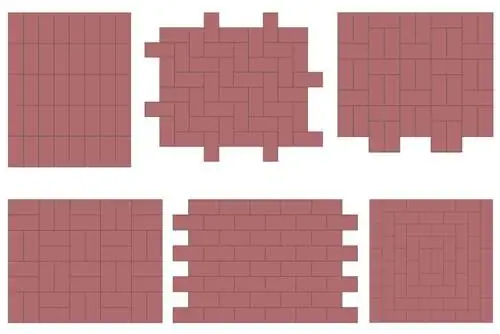
Appearance plays a key role when paving. Therefore, when planning, think about how you will arrange the stones and slabs when laying them. A variety of classic and cutting-edge laying patterns illustrate how you can add the finishing touch to paved surfaces on the terrace and in the garden. The most popular variants are discussed in more detail below:
Wild Association
The laying pattern was copied from the Romans and is primarily suitable for paving with wacker stones. The small to medium-sized stones are arranged irregularly on a surface made of gravel, gravel and sand. In a wild association, geometric shapes are considered a break in style. The only premise for the installation work is the consistent avoidance of cross joints, as these impair the stability of the fixed surface.
Running Association
Paving with standardized concrete blocks in a stretcher bond is simple and perfect for beginners. The stones are cut at the edges and placed next to each other row by row in their original size. It is important to note that there are no cross joints. In concrete terms, this means that you stagger the rows of stones so that the joints in the first row converge towards the middle of the stones in the second row and so on.
Diagonal bandage
The basic structure of the diagonal brace is similar to the runner brace and is just as easy to use. The only difference is the diagonal alignment of the paving stones at a 45 degree angle. Standardized concrete, clinker and natural stones are suitable for the diagonal laying pattern.
Braided bandage
The braided laying pattern raises the bar a bit higher. The method aims to create a pattern like that created in basket weaving. For this purpose, half of the paving stones are cut in half. A whole and a half stone form a pair lying next to each other. The next pair of stones is perpendicular to the previous pair. Continue like this until you reach the edge, where the last pairs of stones can be cut if necessary.
Block Association
The ideal laying pattern for the terrace and seating area in the garden. Two stones are always laid in a parallel block. The next pair of stones abuts in the opposite direction. In this way, a checkerboard pattern is created that accepts the otherwise frowned upon cross joints. This circumstance reduces the stability of the paving surface, so this laying pattern is not suitable for driveways.
arch pavement
Paving in arches and scale shapes is the supreme discipline in paving. Small paving made of natural stone is ideal for this laying pattern. Precise markings with taut cords and a nail compass in the sand bed are essential for a satisfactory result. The starting point for laying is always the arch itself. From here, work your way downwards, arch by arch. Experience has shown that at the end of a sheet the stones become smaller, so for a perfect look you need at least two grit sizes, such as 10/12 and 5/7.
Circle pattern
Circular paved areas mark a focal point in the garden, emphasize the location of eye-catchers and are ideal for the round terrace. For beginners, specialist retailers offer prefabricated concrete blocks that are cast in a wedge shape. Advanced users with a penchant for natural stone choose cobblestones. In contrast to arch paving, the laying work in a circle begins in the center with four stones arranged in a square. Starting from this center point, draw the circle contour in the sand with the nail compass. Guide lines mark the height of the laid stones. When laying, it is important to ensure that the narrow edge lengths point towards the center of the circle and the wide edge lengths point towards the outside. A combination of light and dark paving stones creates a special visual effect.

